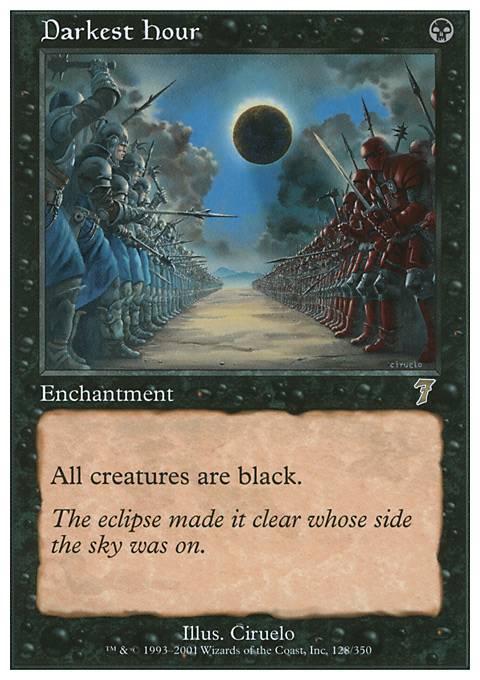
Combos Browse all Suggest
Legality
| Format | Legality |
| 1v1 Commander | Legal |
| Archenemy | Legal |
| Canadian Highlander | Legal |
| Casual | Legal |
| Commander / EDH | Legal |
| Commander: Rule 0 | Legal |
| Custom | Legal |
| Duel Commander | Legal |
| Highlander | Legal |
| Legacy | Legal |
| Leviathan | Legal |
| Limited | Legal |
| Oathbreaker | Legal |
| Planechase | Legal |
| Premodern | Legal |
| Quest Magic | Legal |
| Tiny Leaders | Legal |
| Vanguard | Legal |
| Vintage | Legal |
Darkest Hour
Enchantment
All creatures are black.
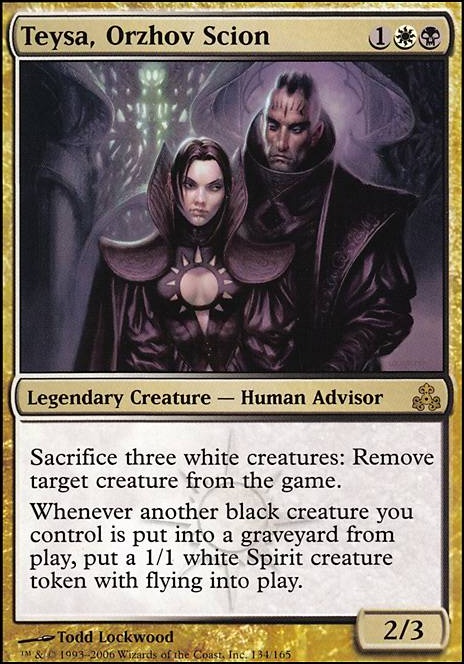
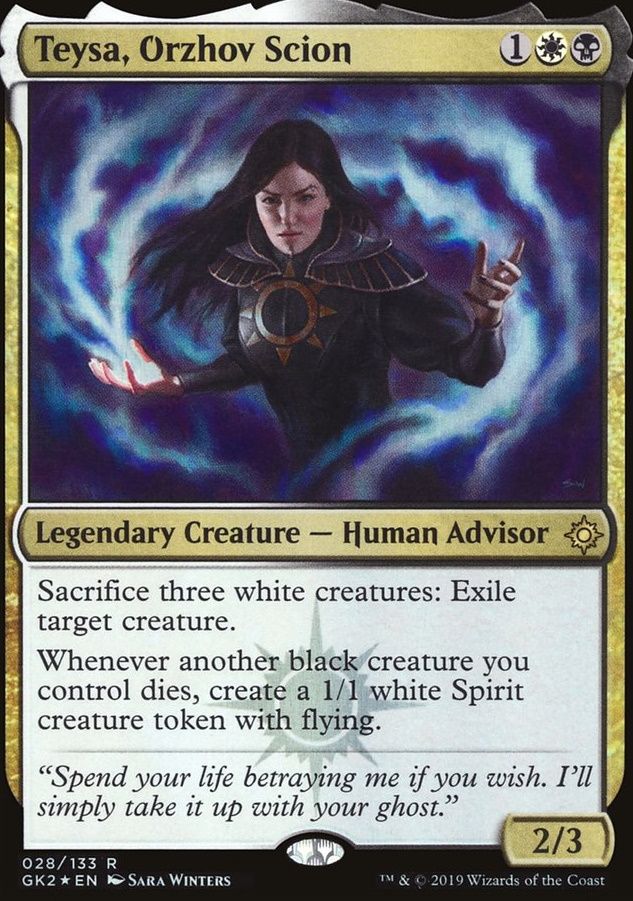
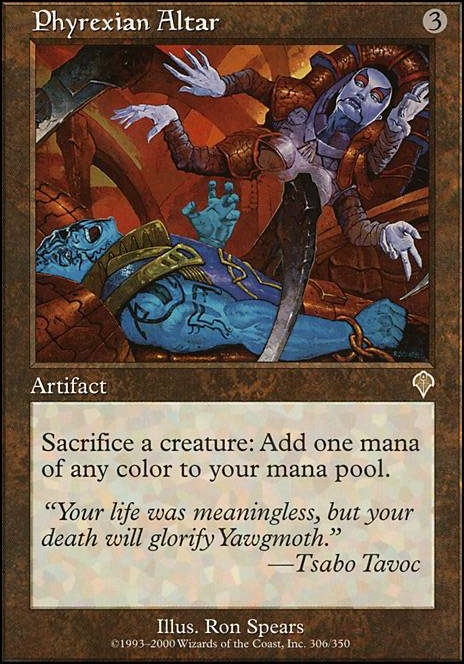
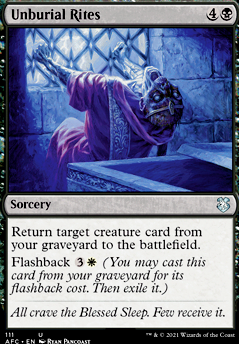
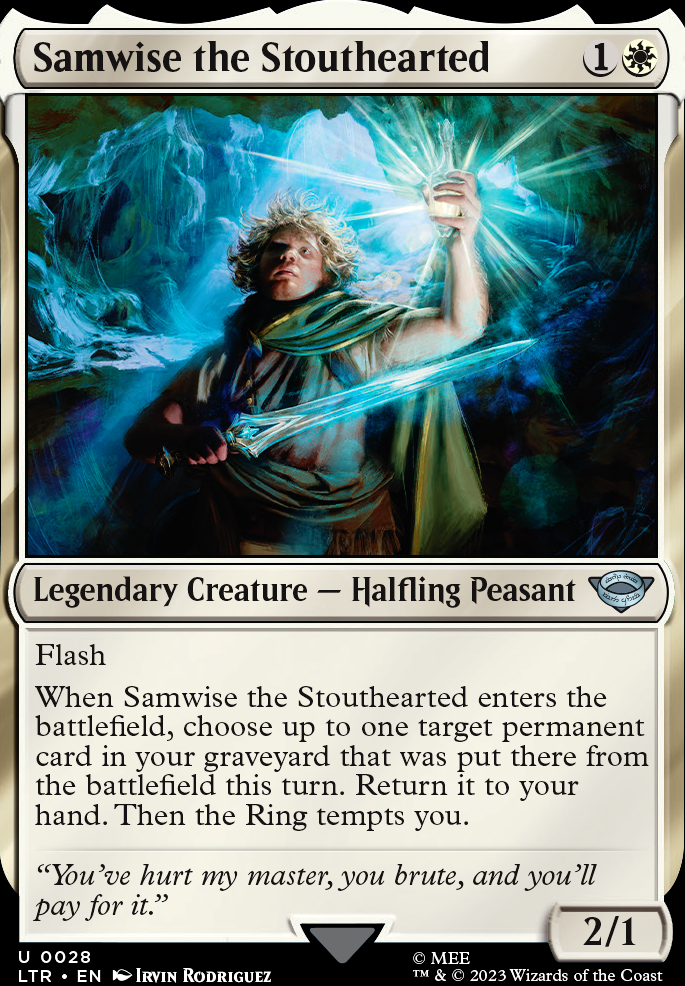
thefiresoflurve on
 Teysa, Orzhov Scion
Teysa, Orzhov Scion
1 year ago
Hey there!
Any current issues you're looking to specifically fix?
If you can spare the lifegain, Martial Coup as a replacement to White Sun's Twilight might synergize better with your commander since the created creatures are white.
Darkest Hour combines with your commander and any sacrifice outlet to make infinite ETB/die effects, if you're interested in that (although I see you don't have a lot of sac outlets).
With your CMC being so low, I might consider cutting Liesa, Shroud of Dusk, since you're likely to be casting a lot.
Swebb87 on darkest hour ideas
1 year ago
Hi. Looking for interesting ideas with Darkest Hour, specifically not with the teysa combo though. Just other Cool things you can do by making all creatures black. Will be running this in a Sidisi, Brood Tyrant
ThePianist on
 Teysa, Ozrhov Scion Combo
Teysa, Ozrhov Scion Combo
1 year ago
Yes correct, You go for Darkest Hour + Teysa, Orzhov Scion and a free sac outlet + payoff and it's infinite, the classic version is with Blasting Station But a Viscera Seer + Blood Artist also does the job, with the infinite black spirit from Teysa
thefiresoflurve on
 Teysa, Ozrhov Scion Combo
Teysa, Ozrhov Scion Combo
1 year ago
Also, I just want to point out that Darkest Hour makes things mono-black. I didn't realize at first how the combo worked - essentially you use Teysa + Darkest Hour + any free sac outlet to get infinite ETB/Death triggers, is that correct?
Guerric on Deck Archetypes in EDH
1 year ago
Hi all! There's an interesting question I've been pondering lately, and I thought I'd share some of my reflections on it and get input from all of you. In sixty card magic we have deck archetypes, namely aggro, control, midrange, combo, and tempo. In commander obviously things look pretty different, and several years ago on the Command Zone podcast they said that like in limited, there aren't really deck archetypes this way, just different flavors of midrange.
As the format has developed and changed a lot over the years I do think something like these archetypes exists in commander, they're just different. For those familiar with sixty card formats some of the hard and fast rules for those archetypes in sixty card magic do not apply, and there certainly is more fluidity on commander and other unique multiplayer strategies as well (ex. Group Hug). Nonetheless, I think the outline of most of these archetypes is still relevant. Here is how I think it plays out-
1) Aggro- I think something more like classic aggro has only become viable in commander in the past couple of years, but I think it is definitely a thing now. In sixty card magic, most creatures are in the one to three drop range, there is often no focus on card draw, and everything in the deck serves to get a single player to zero as quickly as possible. Obviously in commander we need raw engines, some ramp, and are going to play more powerful cards. That being said, I think strategies built around attacking with high value, low cmc creatures from the early game onwards characterizes aggro in commander. This wasn't viable a few years ago due to the lack of board state protection, and really only token pump decks and creature cheat decks tended to do well. But the printing of many premium white board state protection spells like Flawless Maneuver, Teferi's Protection, and Semester's End has changed up the formula a bit. Attacking low to the ground and early is a keystone of aggro strategies, but so are on attack triggers. We have so many of these now, and they incentivize keeping our force swinging every turn. Commanders like Akiri, Fearless Voyager and Trynn, Champion of Freedom incentivize attacking in order to draw cards, make tokens, or do other things the deck is going to want to do. Unlike sixty card magic, we will need to be able to draw cards, and play some removal and interaction, though we'll play fewer pieces of the latter here than in other decks since they compete with resources to keep up the attack. We also need to play one-sided board wipes wherever we have the option, because we can't afford to lose our own board state. We'll also need a way to get through for damage once our opponents' defenses are up, and as such things that give our creatures menace, landwalk, flying, deathtouch or indestructible are key as they help us keep up the assault. We're also very in favor of a few key pump spells to help us finish out the game like Jazal Goldmane or Coat of Arms.
2) Midrange- In sixty card magic midrange is characterized by playing some of the most powerful cards on every point in the curve, and play more removal than aggro decks. Oftentimes they are characterized as "the growing threat." A classic and famous example was the classic Modern Jund deck that Reid Duke piloted several years ago. One of its touchstones was playing Tarmogoyf on turn 2. The goyfs could attack or block where necessary, but they would grow more unstoppable as the game went on, until they were dropping haymakers like Liliana of the Veil. They would use cards like Dark Confidant to keep their hand full till they could inevitably win. In a way, these sorts of decks mirror something of what we see in all commander decks in that they play removal, draw, and powerful cards. Yet what I think sets them apart is this idea of the growing threat, and that they play more removal than aggro decks. One way in which I think some midrange commanders work is to have abilities that allow them to turn other cards into Tarmogoyf like threats. Ezuri, Claw of Progress and Giada, Font of Hope use +1/+1 counters to turn small evasive threates into significant ones. In this sense, I think a lot of counter decks fit well in the midrange categories. These decks will attack, but they don't have to like aggro decks, and are more willing to conserve resources and work on developing board state where feasible. They often have engines that benefit their board passively from the passage of time, and as such they can play more removal and let their board build itself. They still want to protect their board state, and some of the cards from aggro decks that do this or simply counterspells can help with this, and one-sided board wipes are usually th best kind for midrange decks as well.
3) Control- Control decks in sixty card magic are built on trying to shut down almost everything an opponent is trying to do via counterspells and removal until you can work towards a win con. This obviously is not possible in commander where you can not shut down three other players with just counterspells and removal alone, and isn't always necessary since opponents can also shut down each other. As such, controlling strategies fit into two categories: stax and regular control. With stax pieces that shut off lands and mana rocks, eEDH controlling strategies indeed can effectively shut down three other players, usually finding a way to work through it themselves in order to build towards a win con. In standard EDH, heavy land-based stax like that is frowned upon, but cards that disrupt play in other ways (ex. Blind Obedience as well as counterspells and removal are fair game. These decks are still building towards a win con by slowing opponents down, and will devote far more slots to disruption and removal than aggro and midrange decks. They may win with an infinite combo, a planeswalker, a few premium attacking creatures, or in other ways, but most of the deck is devoted to protecting themselves and disrupting opponents. Controlling decks are more likely to play reciprocal board wipes, and generally benefit from keeping the board clear of threats at most times.
4) Combo- Combo decks also exist along a spectrum in EDH, though this archetype is most similar to sixty card magic. The formula is almost unchanged for cEDH, where most of a deck is devoted to playing and protecting a single combo. Outside of cEDH, it is worth mentioning that infinite combos can be included in almost any archetype in the format as a backup win con when other plans go sideways. What makes it a combo deck is that the entire deck is focused on pulling out one of a variety of sometimes elaborate combos, and these decks are generally geared more towards Johnnies than Spikes. A good example would be combo decks built around Teysa, Orzhov Scion that can put together the Darkest Hour in a variety of ways, as well as play Reveillark + Karmic Guide and/or Sanguine Bond + Exquisite Blood in order to win. These decks play out as trying to put together a combo while fending off opponents with removal and interaction.
5) Tempo- Some might argue that there is no such thing as tempo decks in commander, but it's worth mentioning that they're pretty rare even in sixty card magic across formats. In sixty card magic tempo decks adopt a "disruptive aggro" philosophy, where they slowly chip away at an opponent's life total with small, cheap, evasive creatures, while always holding mana open to protect their board and disrupt threats. While "chipping away" life totals isn't much of a strategy in a multiplayer strategy, I do think there are decks that play out along the lines of this disruptive aggro strategy. As an example, Ranar the Ever-Watchful and Alela, Artful Provocateur can be played this way, where the flying tokens they generate are the main win con, and the rest of the deck is devoted to holding mana open to protect this main game plan and stop others from winning. Unlike in sixty card decks these may win all at once with token pump effects or other affects, but this is the main way.
What do you all think? Do you think there are deck archetypes like this in EDH? Why or why not? What qualifications would you add or take away about them if you do?
Guerric on Convoluted Combos
2 years ago
My favorite somewhat elaborate, but also fairly competitive combo is Teysa, Orzhov Scion + Darkest Hour. It feels more fair than other two card combos because it is technically a 4-5 card combo, but other than the above two cards you only need a free sac outlet, something to sacrifice, and a kill card to win, so there are so many ways you can put it together. Also, Darkest Hour only costs , which is the height of efficiency. It is the heart of my Teysa deck, which is probably my favorite one, referenced below. One of these days soon I'll write one of my elaborate primers for it, but it's just so fun, and we're never out on the combo unless Darkest Hour is removed from play, which is why I have other ways to win.
All you Need is Greed (Under Construction)
Commander / EDH
SCORE: 3 | 174 VIEWS | IN 1 FOLDER
Guerric on
 Teysa Karlov, Double Death Budget
Teysa Karlov, Double Death Budget
2 years ago
Hi Zaromin This looks like a fun deck! Just some ideas- I've run Teysa, Orzhov Scion for many years and there are some similarities. Have you though about Nether Traitor, Reassembling Skeleton, or Bloodghast? The latter might push your budget a little bit, but these are all great because they are self-recycling in and out of the graveyard for more and more death triggers. Also, Teysa, Orzhov Scion herself will give you two spirits for every death trigger for a black creature. She can also be one half of a win con with Darkest Hour with a free sac outlet and one of your many aristocrats out. Also, with all of your small creatures the fabulous new card Welcoming Vampire would be an amazing card draw addition.
Guerric on
 Teysa, Orzhov Scion: Life and Death
Teysa, Orzhov Scion: Life and Death
2 years ago
Hi wideline1414! I've been playing Teysa for years, and have had at least three distinct variations of the deck. She's definitely one of my favorite commanders, and the version I'm playing now is very powerful whereas the second incarnation of the deck ended up playing terribly. I am working on writing a full primer for it, but I write very full and ambitious primers and I haven't quite got the time to commit to it yet. I think my biggest piece of advice is that Teysa can do a lot of things, but she can't do everything well, so you really need to focus on the way you want to play her. She can be a great honest token deck, an aggressive and powerful multi-combo deck, an aristocrats deck, or an orzhov goodstuff sort of deck, but she can only do one of these well.
The original version of the deck was a relaxed Orzhov control deck that focused mostly on generating white tokens and using Teysa's exile ability as a sort of threat to get people to leave me alone. I had the Darkest Hour in the deck as a way to win, but I didn't rush towards it, and I usually won via token pump cards like Jazal Goldmane and Mirror Entity. I also had lots of boardwipe and interaction that Orzhov is good with, as well as a bunch of token generating Elspeths, and it could grind out games real well. I really enjoyed the relaxed approach of the deck, but felt like I wasn't getting the most out of Teysa's ability since I didn't have a ton of black token generators, so I set about to rework it to get more value.
I started out well by adding Chittering Witch, Sengir Autocrat, Dreadhorde Invasion, and a bunch of other black token oriented cards. I still run these cards today. Where I went wrong was in stuffing way too many expensive good stuff cards like Elesh Norn, Grand Cenobite and K'rrik, Son of Yawgmoth. My mana curve became accordingly less palatable, and I just found the deck was trying to do too many things to really get anywhere.
Third time's a charm as they say, so I cut most of the good stuff and pretty much all of the token pump support to lean more heavily into combo-control with a life-gain subtheme. The great thing about the Darkest Hour combo is that there are so many cards that support it that are also good on their own, so I made sure to have lots of sac outlets, a few aristocrats, Blasting Station, and both Ashnod's Altar and Phyrexian Altar to make infinite mana to power mass drain spells like Debt to the Deathless, Exsanguinate, and Torment of Hailfire. I also put the Reveillark/Karmic Guide combo in for another combo route. The deck can win without these cards by just draining people out, possibly with mana generated by Smothering Tithe and Pitiless Plunderer, but combos are the thing to go to. My favorite part about all previous versions of the deck were abusing Bolas's Citadel and Necropotence, so I added in the soul sisters, Daxos, Blessed by the Sun, and some other lifegain stuff to support this. The deck as is getting to the point where I won't play it as often with my playgroup because the win rate is getting pretty high.
I like the current version of the deck best, but you should do what is good for you. I'd just focus. If you want to care about attacking with spirit tokens, then by all means play Elesh Norn, Grand Cenobite, Jazal Goldmane, and others. Just try to keep your curve low and have lots of token generators and sac outlets. In my first version of the deck I played most of the Elspeths, and even in the current one I still play Elspeth Tirel and Elspeth, Sun's Champion and they rock the house. If you want to lean into combo or aristocrats, you might want to play fewer of the above cards.
If you are interested in my current list, you can find it here- https://tappedout.net/mtg-decks/teysa-combo-with-superfriends/?cb=1645410923. Hopefully in the next month or so I'll finally get to the primer! Until then, happy magic, and enjoy the best Teysa!
| Have (1) | Azdranax |
| Want (3) | midget_overlord , Kripkenstein , Jayce_Ran |





